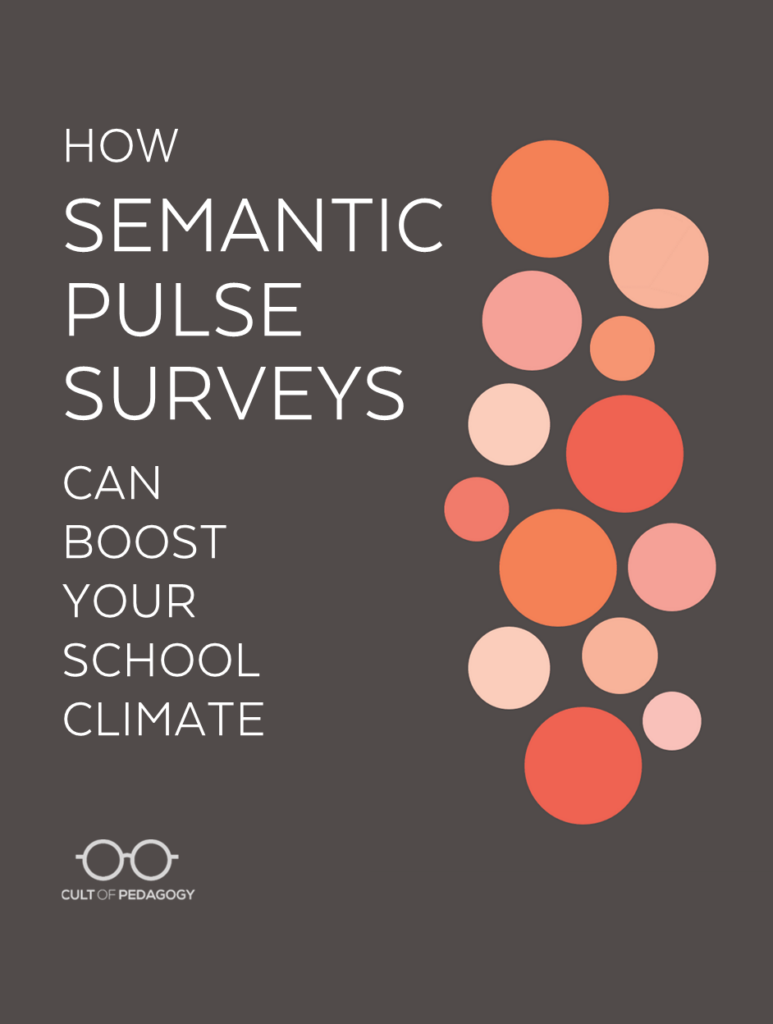
Listen to my interview with Karen Borchert (transcript):
Sponsored by Alpaca
We have a lot of conversations about what should be done to make schools better. In these conversations, I hear a lot of ideas and I have a lot of ideas, but I think there’s one practice that should be done by any school that wants to improve, and it’s simple and free: Ask the people who are directly affected. The students and teachers in your building are the best sources of data on how things are going in your school; when they feel heard, when they believe that their input matters, the climate of your school just gets better. And one of the simplest and most effective ways to make that happen is with a survey.
I’ve been a big advocate of surveys for a long time. I’ve advised teachers to regularly seek feedback from students and I’ve urged principals to get feedback from their teachers. The kinds of surveys I recommended were pretty much what you’d expect — some multiple-choice questions and a lot of Likert scale items, where you have to choose an item from, say, 1 to 5, or a word on a scale that ranges from always to sometimes to never. I also recommended including some open-ended questions to make room for topics that weren’t covered elsewhere.
But earlier this year I saw a different kind of survey that intrigued me. I was wandering through the Expo hall at the SXSW EDU conference in Austin, Texas, and I walked up to this booth where a few iPads were mounted on stands. On one of them was the question “How are you doing?” and below it were a whole lot of words in circles. It looked a lot like this:
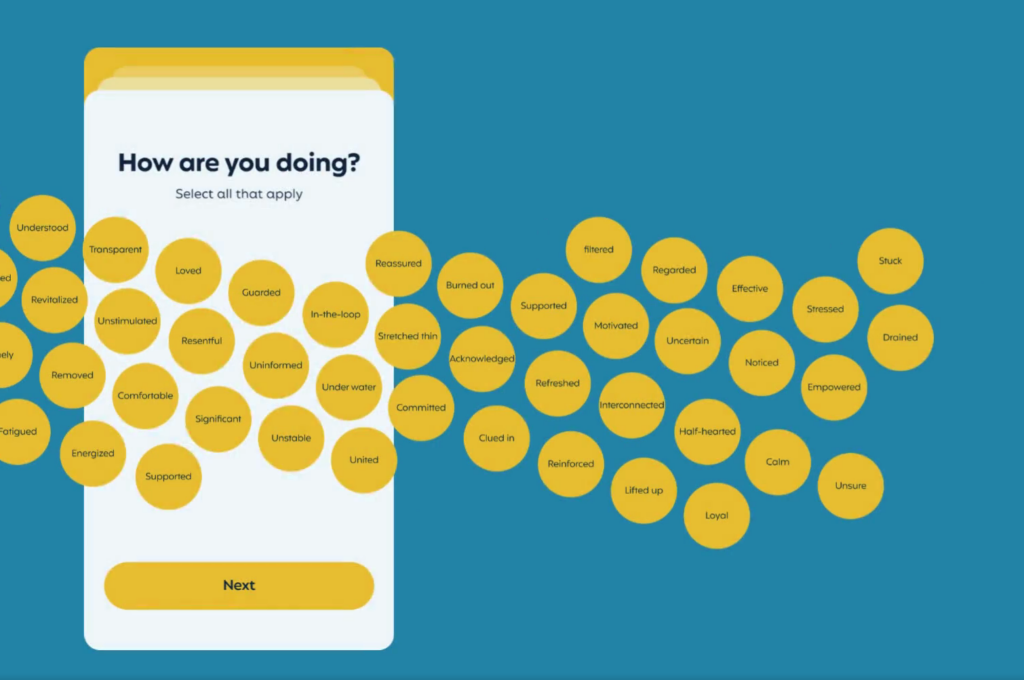
I couldn’t resist. I started tapping circles, and right away, I was engaged. Words I’d never seen on any survey offered themselves for the choosing. Some were positive: refreshed, significant, interconnected, noticed. Others were more negative: drained, half-hearted, filtered, resentful. I tapped a few positive circles because I was having a pretty good day, but I imagined that if I wasn’t, the words in the negative circles would have made me feel seen. I liked that I had the option to choose as many words as I wanted, positive or negative, and the process was fast and instinctive — I never had to pause to think about whether I felt the feeling sometimes, often, or always.
One of the women at the exhibit explained that I was taking a semantic pulse survey, which is built on the idea of the semantic differential, pioneered by psychologist Charles Osgood. You’ve probably seen semantic differential questions before, where two opposite words appear on either end of a scale and you have to choose the spot where your feelings align. Here’s an example from a restaurant:
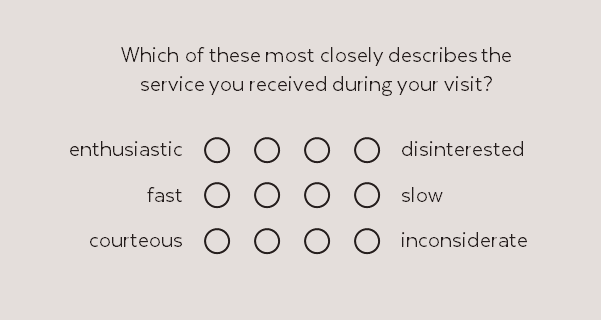
The survey I was taking on the iPad applied that same principle, except instead of choosing between just two words, I could pick any words that sounded right to me.
If I were part of a large group of people taking that same survey, maybe a group of teachers, all of our input could be aggregated into a report that would show how often each word was chosen, giving a snapshot of which feelings were most prevalent among the faculty that day. Our school leadership could then look at those results and respond: If lots of people chose the word noticed, for example, it would suggest that leadership was doing a good job of recognizing people’s contributions and concerns. On the other hand, if the word uncertain came up often, that would warrant further investigation — it could mean that clearer communication or more support was needed.
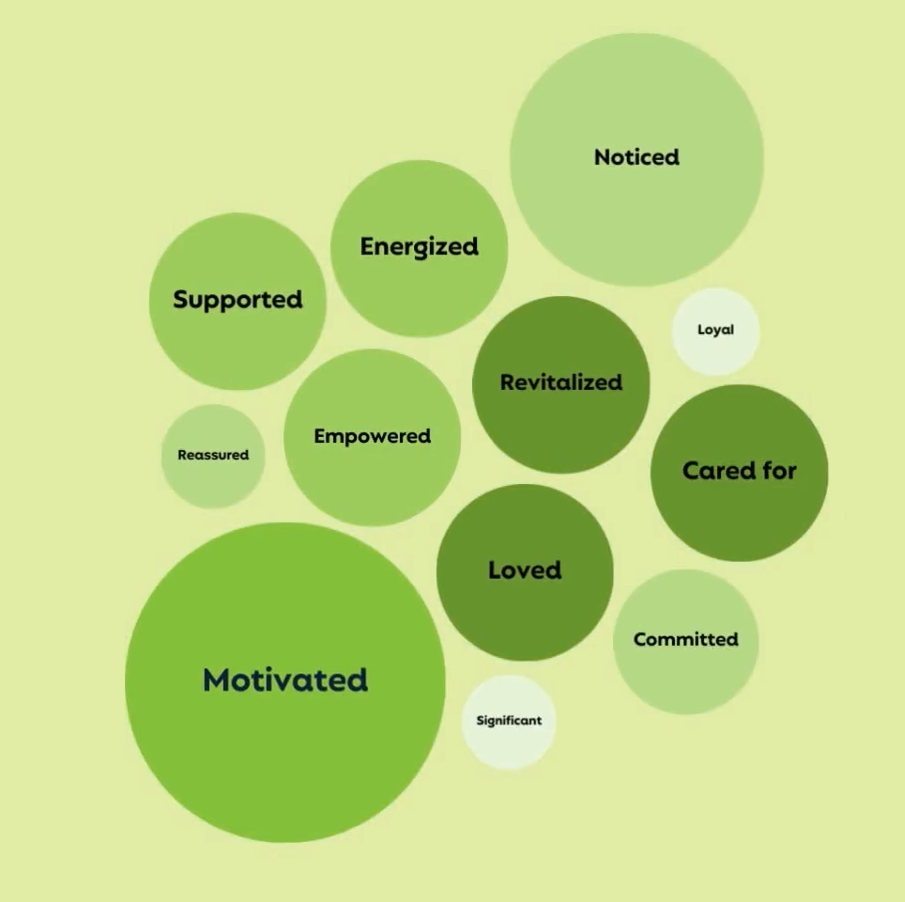
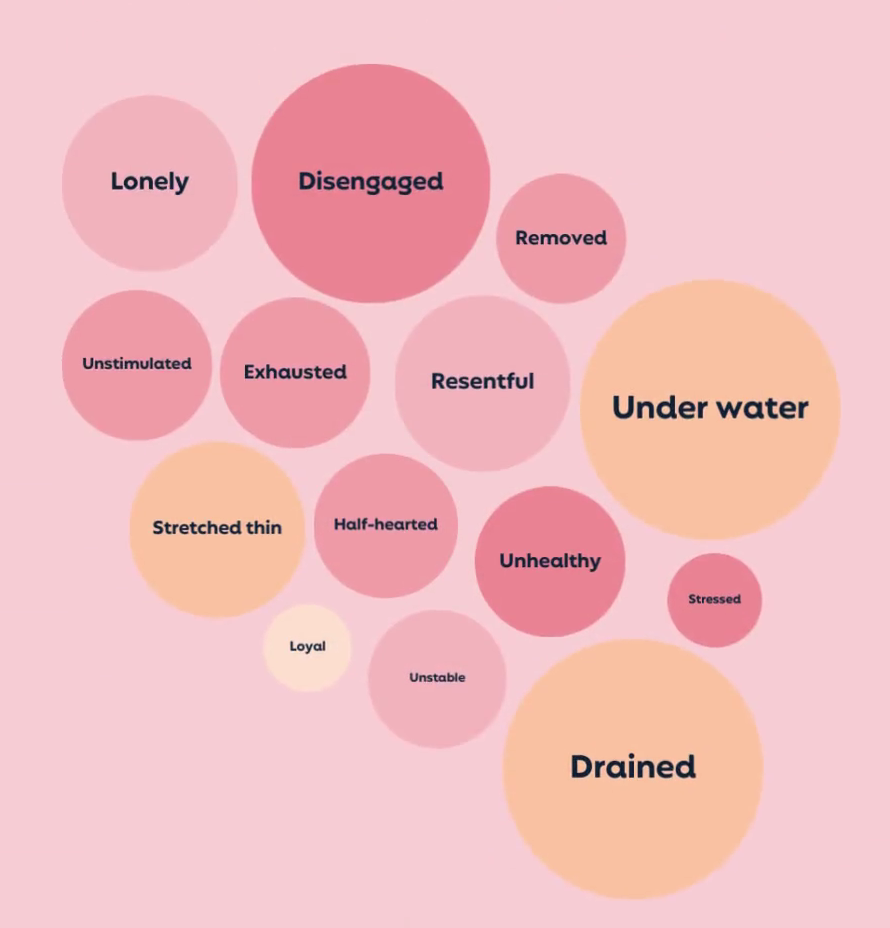
So that explains the “semantic” aspect of this kind of survey. What about the “pulse” part? Widely used in businesses, a pulse survey is one that’s given frequently and can be completed quickly to get a “pulse check” on employees. So a semantic pulse survey combines the word-driven content of a semantic survey with the speed and frequency of a pulse survey.
Surveys like this have the potential to give us much more nuanced information about what’s going on in our schools than other kinds of surveys. They’re easy to create on your own, and below we’re going to look at a few ways to do that.
Now if you’re in school leadership, you could still do it on your own, or you could use the app I tried at that Expo hall booth. It’s called Alpaca, and the woman I was talking to was Karen Borchert, Alpaca’s CEO. When I tried Alpaca I thought, I need to do a podcast episode about this surveying technique, because everyone should be using it, whether or not they use the app. So we decided to devote a whole episode to the topic and have Alpaca sponsor it. Karen joined me on the podcast to talk about how teachers and administrators can create their own semantic pulse surveys, and then we talked about how Alpaca’s platform helps school leaders support their teachers. They have a special offer for Cult of Pedagogy readers, which you can find at the end of this post.
How to Make Your Own Semantic Pulse Survey
Anyone can create this kind of survey on their own — teachers could use it with students and administrators could use it with teachers. Here are some ideas for doing it with different levels of technology (including none at all).
No Tech
- Use the first 5 minutes of a class or meeting to ask the group this question: “What are five words you’d use to describe our school culture today?” or “What are five words you’d use to describe your job (or experience as a student), right now?” Have respondents answer anonymously on slips of paper or Post-it notes, and then review them to see the commonalities.
- For younger students, try a system like colored buckets, each of which represents a different emotion, and have students drop popsicle sticks into whichever buckets best represent their current state of mind.
Medium Tech
- Send out a text, email, or message through an app like Remind with a question like “What is one thing we should start, stop, and continue this week at our school / in our class?” and draw a winner from all respondents for a free snack or other small prize.
- Using a platform like Google Forms, send out one open-ended question like this: “Tell me everything about how you feel about work/our class/this school right now.” Then paste all of the responses into ChatGPT and ask it to summarize the responses or create a list of 50-100 words based on how the respondents feel.
More Tech
Use a survey platform like Google Forms, SurveyMonkey, or Typeform (Borchert’s favorite) to develop your own semantic pulse survey, where you ask a question like “How are you feeling about work/school/this class this week?”, offer a large bank of words for respondents to choose from and allow them to pick as many as they like. The frequency of each choice can then be summarized for you when the responses come in. To get the words, Borchert recommends starting with an open-ended question like the one above to gather a good collection for the word bank.
How Alpaca’s Pulse Surveys Support Teacher Wellness
If you’re an administrator and you’d like this process done for you, Alpaca offers two services that help administrators better meet their teachers’ needs.
The first is a monthly semantic pulse survey like the one I described in the opening of this post. “It’s a survey that goes out once a month to everyone in the building,” Borchert explains. “Some of our schools will do it as part of their team meeting or their staff meeting. Some will do it individually. It’s a mobile-friendly survey — the whole point is you’ve got to be able to do it in less than a minute, really fast, really easy.” The survey is completely anonymous — no email required to complete it, which also keeps it fast.
When the surveys are complete, school leaders get a simple report with insights on how their staff is feeling that month, along with suggested action steps and selections from Alpaca’s excellent library of resources for supporting teachers.
The second service, which can be combined with the surveys, is their teacher recognition packs, which Borchert describes as “kind of like Stitch Fix for teachers.” The monthly care packages contain supplies teachers often run out of, snacks and treats, and other surprises. School leaders often combine these with the surveys, setting aside a few minutes during faculty meetings to have staff members complete the survey, then celebrate by giving out a few packs.
School leaders can do just the surveys, just the teacher recognition packs, or both. This video shows you how it works:
Special Offer to Cult of Pedagogy Readers
Good news for school leaders who want to try Alpaca’s surveying: They are offering 15% off for a year of semantic pulse surveying to Cult of Pedagogy readers. Learn more at alpacapacks.com/pedagogy.
Join our mailing list and get weekly tips, tools, and inspiration that will make your teaching more effective and fun. You’ll get access to our members-only library of free downloads, including 20 Ways to Cut Your Grading Time in Half, the e-booklet that has helped thousands of teachers save time on grading. Over 50,000 teachers have already joined—come on in.





Another tool that I’ve recently discovered — which might work to take a quick pulse — is Curipod. You can ask a quick question, then have the responses show up in a word cloud.
That being said, this tool looks super-engaging!
Thanks for sharing this suggestion, Kerri!
A great idea for gathering feedback on student wellbeing. I think I would give the kids words to choose from with options for more, to give them words to name feelings and attitudes. And I could have them bilingually, so they are exposed to them in German.
I like the restaurant words as well and the sliding scale.
How do you feel about the topic we are studying?
enthusiastic – – – – – disinterested
How did you find the explanation about the grammar point today?
too fast —-just right—– too slow
confident ——— Help!
How do you feel about today’s test?
nailed it – – — – – brain freeze
Thanks for sharing your ideas, Catherine! Adding a bilingual component could be powerful in many different contexts.
What about a workplace where people have a resistance to filling out surveys–they don’t feel they are really anonymous and fear retribution? Any ideas for how to shift that culture?
Jay, thanks for offering this question! Cultivating genuine trust and a deep sense of safety among staff within a school environment can be gradual, tough work. Several of Jenn’s posts for school administrators discuss methods of addressing teacher needs and improving school culture in meaningful ways. This post gives some ideas for how school leaders might frame invitations for feedback specifically within the context of staff surveys, and several of the other posts have suggestions for shifting school culture, in general. I hope this helps!